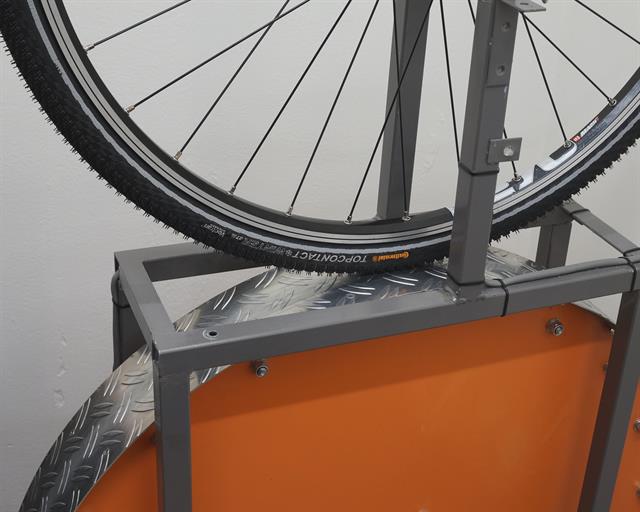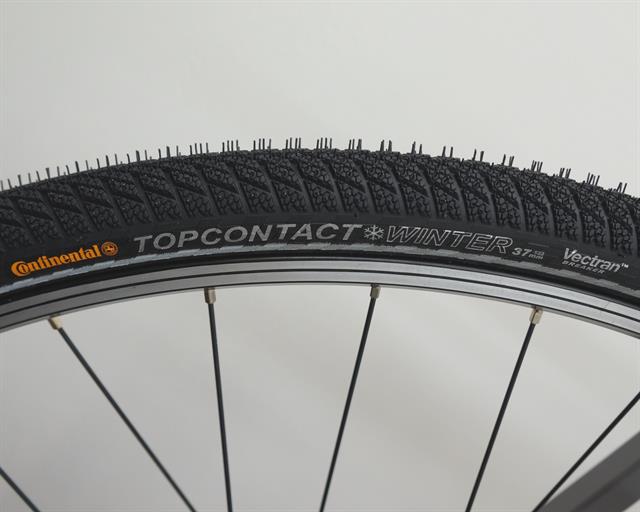Touring Bike Tire Test: Continental Top Contact Winter II
Contents and Test Summary
- Introduction
- Manufacturer Specifications
- Size, Weight, Thickness
- Rolling Resistance: 28.5 Watts
- Puncture Resistance: 119 Points
- Static Wet Grip: No Data
- Conclusion: 4.0 / 5 Recommended
- Comments
- Continental Top Contact Winter II
(100% is best)

The Continental Top Contact Winter II Premium is one of the few winter tires available (excluding spike tires) for bicycles. The Top Contact Winter II is closely related to the regular Top Contact II (read review). Just like the regular Top Contact II, the Winter II uses a 3/180 folding casing with a Vectran puncture protection insert. The biggest difference can be found in the softer winter compound and ribbed tread design based on Conti's knowledge of winter tires for cars.
Ad Buy Continental Top Contact Winter II at Amazon.com
The Top Contact Winter II is the only bicycle tire (that I'm aware of) that comes with the ribbed tread design that pretty much all winter tires for cars rely on. The ribbed tread profile is known to increase grip on snowy or icy roads dramatically. I don't see a reason why this shouldn't work just as well for bike tires as it does for car tires. If you're looking for non-spike winter tires for your bike, the Top Contact Winter II seems to be miles ahead of the competition on paper.
Manufacturer Specifications
| Manufacturer Specs | |
|---|---|
| Brand | Continental |
| Model | Top Contact Winter II |
| Year | 2016 |
| Supplied By | Bought in store |
| New or Used | New |
| Mileage | 0 km |
| Price Range | High |
| Buy At | Ad Amazon.com |
| Manufacturer part number | 0100713 |
| TPI | 3/180 |
| Compound | Winter compound |
| Bead | Folding |
| ETRTO | 37-622 |
| Size Inch | 28" |
| Width mm | 37.00 |
| Specified Weight | 470 grams |
| Max Air Pressure (psi) | 85 |
| Made In | Members Only |
| Available Sizes |
42-622 (28x1.60) 37-622 (28x1.40) 55-559 (26x2.20) 50-559 (26x1.90) |
Continental Top Contact Winter II Test Results

Size, Weight, and Thickness Measurements
| Size, Weight, and Thickness Measurements | |
|---|---|
| Specified Weight | 470 grams |
| Measured Weight | 468 grams |
| Measured Width | 32 mm (un-round) |
| Measured Height | 32 mm (un-round) |
| Tread Depth | 2.3 mm |
| Total Tire Thickness Center | 5.5 mm |
| Total Tire Thickness Sidewall | Members Only |
| All size measurements are taken at an air pressure of 60 psi / 4 bars on a 17.8 mm inner width rim. | |
On a 17C rim, inflated to an air pressure of 60 psi / 4 bars, the Top Contact Winter II measures just 32 mm wide. 32 mm is small for a tire advertised as a 37-622 tire. I'm not sure if Conti made these tires smaller on purpose (to increase grip on snow), but this should have been a 32-622 / 35-622 rated tire. Be aware of this when buying these tires, a 42-622 version is available as well.
Tread depth comes in at a very average 2.3 mm which doesn't appear to be that impressive as the regular Top Contact II has a tread depth of 2.5 mm. The total thickness of the tire at the center of the tread is 5.5 mm; the sidewalls have a thickness of 0.85 mm. For reference, the regular Top Contact II came in at 4.4 / 1.05 mm.
Rolling Resistance Test Results
| Rolling Resistance Test Results | |
|---|---|
| Inner Tube | Conti Tour 28 (170 gr butyl) |
| Rolling Resistance 75 PSI / 5 Bar |
27.0 Watts CRR: 0.00809 |
| Rolling Resistance 60 PSI / 4 Bar |
28.5 Watts CRR: 0.00854 |
| Rolling Resistance 45 PSI / 3 Bar |
Members Only |
| Rolling Resistance 30 PSI / 2 Bar |
Members Only |
| All numbers are for a single tire at a speed of 29 km/h / 18 mph and a load of 42.5 kg / 94 lbs. Use the formula: RR (Watts) = CRR * speed (m/s) * load (N) to calculate rolling resistance at a given speed and load. |
|
Maybe rolling resistance isn't the main criteria to look for when buying winter tires, but it's always nice to know how they perform in this test as well. Compared to the Top Contact II (read review), the Top Contact Winter II performs only slightly worse in the rolling resistance test. When compared to the best performing (summer) touring bike tires (touring bike overview), rolling resistance can be up to 50% higher.
How much power is lost precisely greatly depends on the air pressure used. When compared to the Top Contact II (that isn't the fastest tire out there), at the typical touring bike air pressure of 60 psi / 4 bars, the Winter II needs an extra 15-20% (4.3 watts) of power input to reach the same speed. At the higher end of the air pressure range (75-90 psi / 4-5 bars), an extra 25% of power is lost in the tires (5-6 watts per tire). At lower air pressures, the Winter II closes the gap considerably (less than 10%).
Puncture Resistance Test Results

| Puncture Resistance Test Results (higher is better) | |
|---|---|
| Total Puncture Score Tread | 119 Points |
| Total Puncture Score Sidewall | Members Only |
| Tread Puncture Force Sharp Needle | 17 Points |
| Tread Puncture Force Blunt Needle | No Data |
| Tread Total Tire Thickness | 5.5 mm |
| Sidewall Puncture Force Sharp Needle | Members Only |
| Sidewall Puncture Force Blunt Needle | No Data |
| Sidewall Total Tire Thickness | Members Only |
In the puncture resistance tread test, the Top Contact Winter II performs very strong. With a score of 17 points in the tread test, it outperforms the Top Contact II by 1 point. In the sidewall test, performance isn't as strong but still decent.
On the Puncture Factor Tread calculation, the Winter II performs even better as the total tread thickness has gone up to 5.5 mm (compared with the Top Contact II) which results in a Puncture Factor score of 94 points. 94 points is a very decent score; these tires will be hard to flat. Puncture Factor Sidewall, on the other hand, is a bit on the low side for a touring bike tire but it shouldn't cause too many troubles.
Static Grip Test Results
NOTE: Grip test data is only available on tires tested after November 2018. You can find more information about our grip test here: Introducing Grip Testing
| Static Grip Test Results | |
|---|---|
| Wet Grip Average | No Data |
| Wet Grip Center | No Data |
| Wet Grip Edge | No Data |
| Grip in points = coefficient of friction * 100 Tour/E-Bike grip test rim width = 23.0 mm |
|
Conclusion
- Continental Top Contact Winter II
(100% is fastest - lightest - thickest - strongest)
Grip on snow and ice will be the most important reason of why you'd want to buy a tire like the Continental Top Contact Winter II Premium. I'm sure grip on snowy and icy roads will be as good as it gets for a tire that doesn't use spikes as these tires use the same proven concept used on winter tires for cars. Rolling resistance isn't the most important thing to consider, but I feel it is good to know how these tires perform. It also might help to decide if it's worth it to change to summer tires when the weather improves.
Another good thing to know is puncture resistance is excellent as well. You do not want to be stranded with a flat tire when it's cold outside! Another thing to remember is the actual size of the 37-622 rated version of this tire is just 32 mm wide. If you're looking for a large tire, go with the 42-622.
Ad Buy Continental Top Contact Winter II at Amazon.com
RATING:
4.0
/ 5
TEST VERDICT:
Recommended
